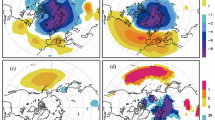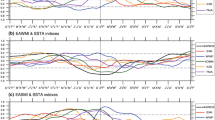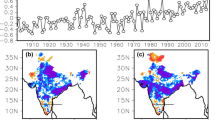Abstract
The southeastern Brazilian coast is a vulnerable region to the development of severe storms, mainly caused by the passage of cold fronts and extratropical cyclones. In the last decades, there has been an increase in the occurrence of subtropical cyclones. This study investigates trends and climatic variations, analyzing surface meteoceanographic series at six grid points from the reanalysis databases of ERA-Interim and ERA5 (European Center for Medium-Range Weather Forecasts (ECMWF)) from 1979 to 2018 over the ocean region bounded, approximately, at 18°S, 25°S, and 37ºW, 45ºW (between the states of Espírito Santo, Rio de Janeiro, and São Paulo). Non-parametric statistical tests and the generalized extreme value distribution are employed for annual, seasonal, and daily maxima/minima. The numbers of occurrence of extreme values, as well as the extremal index, are also estimated in order to better understand the behavior of extremes. Annual maximum sea-surface temperature anomalies of the ERA-Interim databases show very low negative values, mainly at the beginning of measurements (between 1979 and 1982), leading to high positive trend values. The results are compared to the updated data from ERA5 which have anomalies that are more homogeneous with positive trends but without statistical significance. The other meteorological series of the ERA-Interim does not present discrepancies. Only the maximum anomalies of air temperature have significant annual and seasonal positive trends at grid points near the coast of Rio de Janeiro and São Paulo. Despite that the analyses for pressure and wind speed anomalies do not indicate significant trends, they present increases in the interdecadal pattern of the numbers of occurrence of extreme percentiles for almost every grid point. Return levels for 10, 25, 50, 75, and 100 years are estimated at each grid point, and many maximum/minimum peaks are close to the return levels for 100-year return periods. The extremal index suggests average cluster sizes associated with no predominance of clustering for the extreme percentiles, which represents weak dependence between the exceedances. These results characterize some independence between extreme meteorological events such as the event that has been taking place in the region. The occurrence of maximum daily wind speed peaks calculated in austral spring, whose values exceeded the previous ones, is identified at three grid points near the southeast Brazilian coast, caused by the passage of the subtropical cyclone “Deni,” which occurred in November 2016.
Similar content being viewed by others
Data availability
ERA5 data: https://www.ecmwf.int/en/forecasts/datasets/reanalysis-datasets/era5. extRemes_R-2.0–8.tar.gz: R source package.
Code availability
v72i08.R: R replication code.
References
Arikan BB, Kahya E (2019) Homogeneity revisited: analysis of updated precipitation series in Turkey. Theor Appl Climatol 135:211–220. https://doi.org/10.1007/s00704-018-2368-x
Appiotti F, Krzelj M, Russo A, Ferretti M, Bastianini M, Marincioni F (2014) A multidisciplinary study on the effects of climate change in the northern Adriatic Sea and the Marche region (central Italy). Reg Environ Change 14:2007–2024. https://doi.org/10.1007/s10113-013-0451-5
Back AJ (2001) Application of statistical analysis for identification of climatic tendency. Pesq Agrop Bras 36:717–726. https://doi.org/10.1590/S0100-204X2001000500001
Barros V, Gonzalez M, Liebmann B (2000) Influence of the South Atlantic convergence zone and South Atlantic sea surface temperature on interannual summer rainfall variability in Southeastern South America. Theor Appl Climatol 67:123–133. https://doi.org/10.1007/s007040070002
Berrisford P, Dee DP, Poli P, Brugge R, Fielding M, Fuentes M, Kållberg PW, Kobayashi S, Uppala S (2011) The ERA-Interim archive version 2.0, ERA report series, Shinfield Park, United Kindon, http://www.ecmwf.int/publications/. Accessed 25 march 2019
Benstock D, Cegla F (2017) Extreme value analysis (EVA) of inspection data and its uncertainties. NDT&E International 87:68–77. https://doi.org/10.1016/j.ndteint.2017.01.008
Bombardi RJ, Carvalho LMV, Jones C, Reboita MS (2014) Precipitation over eastern South America and the South Atlantic sea surface temperature during neutral ENSO periods. Climate Dyn 42:1553–1568. https://doi.org/10.1007/s00382-013-1832-7
Brabson BB, Palutikof JP (2000) Tests of the generalized pareto distribution for predicting extreme wind speeds. J Appl Meteorol and Climatol 39:1627–1640. https://doi.org/10.1175/1520-0450(2000)039%3c1627:TOTGPD%3e2.0.CO;2
Cai J-J (2019) A nonparametric estimator of the extremal index. arXiv:1911.06674v1 [math.ST] 15 Nov 2019. https://arxiv.org/pdf/1911.06674.pdf
Campos ED, Miller JL, Peterson MTJ, RG, (1995) Physical oceanography of the Southwest Atlantic Ocean. Oceanogr 8:87–91. https://doi.org/10.5670/oceanog.1995.03
Chaves RR, Nobre P (2004) Interactions between sea surface temperature over the South Atlantic Ocean and the South Atlantic convergence zone. Geophys Res Lett 31:L03204. https://doi.org/10.1029/2003GL018647
Cheng L, Aghakouchak A, Gilleland E, Katz RW (2014) Non-stationary extreme value analysis in a changing climate. Clim Change 127:353–369. https://doi.org/10.1007/s10584-014-1254-5
Cheng L, Zhu J, Abraham J, Trenberth KE, Fasulo JT, Zhang B, Yu F, Wan L, Chen X, Song X (2019) 2018 continues record global ocean warming. Adv Atmos Sci 36:249–252. https://doi.org/10.1007/s00376-019-8276-x
Cheng L et al (2020) Record-setting ocean warmth continued in 2019. Adv Atmos Sci 37:137–142. https://doi.org/10.1007/s00376-020-9283-7
Coles S (2007) An introduction to statistical modeling of extreme values. Springer-Verlag, London
Collins M, Minobe S, Barreiro M, Bordoni S, Kaspi Y, Kuwano-Yoshida A et al (2018) Challenges and opportunities for improved understanding of regional climate dynamics. Nat Clim Change 8:101–108. https://doi.org/10.1038/s41558-017-0059-8
Compo GP, Whitaker JS, Sardeshmukh PD, Matsui N, Allan RJ et al (2011) The twentieth century reanalysis project. Q J R Meteorol Soc 137:1–28. https://doi.org/10.1002/qj.776
D’Agostino R, Lionello P (2017) Evidence of global warming impact on the evolution of the Hadley Circulation in ECMWF centennial reanalyzes. Clim Dyn 48:3047–3060. https://doi.org/10.1007/s00382-016-3250-0
da Silva RM, Santos CAG, Moreira M, Corte-Real J, Silva VC, Medeiros IC (2015) Rainfall and river flow trends using Mann-Kendall and Sen’s slope estimator statistical tests in the Cobres River basin. Nat Hazards 77:1205–1221. https://doi.org/10.1007/s11069-015-1644-7
de Oliveira MMF, Ebecken NFF, de Oliveira JLF, Gilleland E (2011) Generalized extreme wind speed distributions in South America over the Atlantic Ocean region. Theor Appl Climatol 104:377–385. https:/doi.org/https://doi.org/10.1007/s00704-010-0350-3
de Oliveira MMF, Pereira GC, de Oliveira JLF, Ebecken NFF (2012) Large and mesoscale meteo-oceanographic patterns in local responses of biogeochemical concentrations. Environ Monit Assess 184:6935–6956. https://doi.org/10.1007/s10661-011-2470-3
de Oliveira MMF, Pereira GC, de Oliveira JLF, Ebecken NFF (2013) Effects of sea level variation on biological and chemical concentrations in a coastal upwelling ecosystem. J Environ Prot 4:61–76. https://doi.org/10.4236/jep.2013.411A008
Dee DP, Uppala S (2009) Variational bias correction of satellite radiance data in the ERA-Interim reanalysis. Q J R Meteorol Soc 135:1830–1841. https://doi.org/10.1002/qj.493
Dee DP, Uppala SM, Simmons AJ, Berrisford P, Poli P (2011) The ERA-Interim reanalysis: configuration and performance of the data assimilation system. Bull Amer Meteor 137:553–597. https://doi.org/10.1002/qj.828
Di Giulio GM, Torres RR, Vasconcellos MP, Braga DRGC, Mancini RM, Lemos MC (2019) Extreme events, climate change and adaptation in the state of São Paulo. Ambient Soc 22:1–20. https://doi.org/10.1590/1809-4422asoc0277r1vu19l4ao
Donlon CJ, Martin M, Stark J, Roberts-Jones J, Fiedler E, Wimmer W (2012) The operational sea surface temperature and sea ice analysis (OSTIA) system. Remote Sens Environ 116:140–158. https://doi.org/10.1016/j.rse.2010.10.017
Easterling WE, Aggarwal, PK, Batima, P, Brander KM, Erda L, Howden SM, Kirilenko A, Morton J, Soussana JF, Schmidhuber J, Tubiello FN (2007) Food, fibre and forest products. In book: Climate change: impacts, adaptation and vulnerability. Contribution of Working Group II to the Fourth Assessment Report of the Intergovernmental Panel on Climate Change, Chapter: 5, Publisher: Cambridge University Press, Cambridge, UK, Editors: M. L. Parry, O. F. Canziani, J. P. Palutikof, P. J. van der Linden, C. E. Hanson, 273–313
Escalante-Sandoval CA (2013) Estimation of extreme wind speed gy using mixed distribution. Ingeniería Investigación y Tecnología 14:153–162. https://doi.org/10.1016/s1405-7743(13)72233-9
Evans JL, Braun A (2012) A climatology of subtropical cyclones in the South Atlantic. J Climate 25:7328–7340. https://doi.org/10.1175/JCLI-D-11-00212.1
Ferreira M (2018) Heuristic tools for the estimation of the extremal index: a comparison of methods. REVSTAT-Statistical Journal 16:115–136
Fisher RA, Tippett LHC (1928) Limiting forms of the frequency distributions of the largest or smallest members of a sample. Proc Cambridge Phil Soc 24:180–190
Gan MA, Rao VB (1991) Surface cyclogenesis over South America. Mon Wea Rev 119:1293–1302. https://doi.org/10.1175/1520-0493(1991)119,1293:SCOSA.2.0.CO;2
Garcia-Cueto R, Santillán-Soto N (2012) Modeling extreme climate events: two case studies in Mexico. In Leonard Druyan (ed) Climate Models, Intech, Rijeka, pp 137–160
Garzoli SL, Matano RP (2011) The South Atlantic and the Atlantic meridional overturning circulation. Deep-Sea Res Part II Topical Studies in Oceanography 58:1837–1847. https://doi.org/10.1016/j.dsr2.2010.10.063
Gavrilov MB, Tosic I, Markovic SB, Unkasevic M, Petrovic P (2016) Analysis of annual and seasonal temperature trends using the Mann-Kendall test in Vojvodina, Serbia. Idoejaras 120:183–198
Gilleland E, Katz RW (2006) Analyzing seasonal to interannual extreme weather and climate variability with the extremes toolkit, in: 18th Conference on Climate Variability and Change, 86th American Meteorological Society (AMS), Annual Meeting, 29 January - 2 February, Atlanta, Georgia. Accessed 06 Sep 2020
Gilleland E, Ribatet M, Stephenson AG (2013) A software review for extreme value analysis. Extremes 16:103–119. https://doi.org/10.1007/s10687-012-0155-0
Gilleland E (2015) Introduction to extreme value analysis. Satellite Workshop on Statistical Computing for Extremes, College of Literature Science and the Arts, University of Michigan, 14–19 June 2015, Ann Arbor, Michigan. Accessed 22 July 2020
Gilleland E, Katz RW (2016) extRemes 2.0: an extreme value analysis package in R. J Stat Softw 72:1–39. https://doi.org/10.18637/jss.v072.i08
Gozzo LF, da Rocha RP, Reboita MS, Sugahara S (2014) Subtropical cyclones over the southwestern South Atlantic: climatological aspects and case study. J Clim 27:8543–8562. https://doi.org/10.1175/JCLI-D-14-00149.1
Gozzo LF, da Rocha RP, Gimeno L, Drumond A (2017) Climatology and numerical case study of moisture sources associated with subtropical cyclogenesis over the southwestern Atlantic Ocean. J Geophys Res Atmos 122:5636–5653. https://doi.org/10.1002/2016JD025764
Guishard MP, Evans JL, Hart RE (2009) Atlantic subtropical storms. Part II: Climatology J Clim 22:3574–3594. https://doi.org/10.1175/2008JCLI2346.1
Gumbel EJ (1954) Statistical theory of extreme values and some practical applications. Applied Mathematics Series, 33. U.S. Department of Commerce, National Bureau of Standards
Hersbach H, Bell B, Berrisford P, Hirahara S, Horányi A et al (2020) The ERA5 global reanalysis. QJR Meteorol Soc 146:999–2049. https://doi.org/10.1002/qj.3803
Hirahara S, Balmaseda MA, de Boisseson E, Hersbach H (2016) Sea surface temperature and sea ice concentration for ERA5. ERA Report Series 26, Reading, UK. https://www.ecmwf.int/sites/default/files/elibrary/2016/16555-sea-surface-temperature-and-sea-ice-concentration-era5.pdf. Accessed 08 July 2020
Hoskins BJ, Hodjes KI (2005) A new perspective on Southern Hemisphere storm tracks. J Clim 18:4108–4129. https://doi.org/10.1175/JCLI3570.1
IPCC (2009): Summary for policymakers. In: IPCC special report on the ocean and cryosphere in a changing climate. https://www.ipcc.ch/srocc/chapter/summary-for-policymakers/. Accessed 18 September 2020
Kendall MG (1975) Rank correlation measures. Charles Griffin, London
Kocsis T, Székely IK, Anda A (2020) Homogeneity tests and non-parametric analyses of tendencies in precipitation time series in Keszthely, Western Hungary. Theor Appl Climatol 139:849–859. https://doi.org/10.1007/s00704-019-03014-4
Leadbetter MR, Lindgren G, Rootzen H (1983) Extremes and related properties of random sequences and processes. Springer-Verlag, New York
Liu L, Xu ZX, Huang JX (2012) Spatio-temporal variation and abrupt changes for major climate variables in the Taihu Basin, China. Stoch Environ Res Risk Assess 26:777–791. https://doi.org/10.1007/s00477-011-0547-8
Malevergne Y, Pisarenko V, Sornette D (2006) On the power of generalized extreme value (GEV) and generalized pareto distribution (GPD) estimators for empirical distributions of stock returns. Appl Financial Econ 16:271–289. https://doi.org/10.1080/09603100500391008
Mann HB (1945) Non-parametric test against trend. Econometrica 13:245–259. https://doi.org/10.0012/9682(194507)13:3%3c245:NTAT%3e2.0.CO;2-U
Mascaro G (2018) On the distributions of annual and seasonal daily rainfall extremes in central Arizona and their spatial variability. J Hydrol 559:266–281. https://doi.org/10.1016/j.jhydrol.2018.02.011
McClain EP, Pichel WG, Walton CC (1985) Comparative performance of AVHRR-based multichannel sea-surface temperatures. JGR Oceans 90:1587–1601. https://doi.org/10.1029/JC090iC06p11587
Orlansky O (1975) A rational subdivision of scales for atmospheric processes. Bull Am Meteorol Soc 56:527–530. https:/www.jstor.org/stable/i26215014
Pereira JM, Paiva VH, Ceia FR, Ramos JA (2020) Facing extremes: Cory’s shearwaters adjust their foraging behavior differently in response to contrasting phases of North Atlantic Oscillation. Reg Environ Change 20:77. https://doi.org/10.1007/s10113-020-01662-1
Perrin O, Rootzén H, Taesler R (2006) A discussion of statistical methods used to estimate extreme wind speeds. Theor Appl Climatol 85:203–215. https://doi.org/10.1007/s00704-005-0187-3
Peterson RG, Stramma L (1991) Upper-level circulation in the South Atlantic Ocean. Progress in Oceanography 26:1–73
Pettitt AN (1979) A non-parametric approach to change point problem. Appl Statist 28:126–135
Pezzi LP, de Souza RB, Quadro MFL (2016) A review on the ocean-atmosphere interaction processes in regions of strong sea surface temperature gradients of the South Atlantic Ocean based on observational data. Rev Bras Meteorol 31:428–453. https://doi.org/10.1590/0102-778631231420150032
Piola AR, Campos EJD, Mõller OO, Charro M, Martinez C (2000) The subtropical shelf front off eastern South America. J Geophys Res 105:6565–6578. https://doi.org/10.1029/1999JC000300
Reboita MS, da Rocha RP, Ambrizzi T, Caetano E (2010) An assessment of the latent and sensible heat flux on the simulated regional climate over southwestern South Atlantic Ocean. Clim Dyn 34:873–889. https://doi.org/10.1007/s00382-009-0681-x
Reboita MS, da Rocha RP, de Oliveira DM (2019) Key features and adverse weather of the named subtropical cyclones over the Southwestern South Atlantic Ocean. Atmosphere 10:1–21. https://doi.org/10.3390/atmos10010006
Reynolds RW, Rayner NA, Smith TM, Stokes DC, Wang W (2002) An improved in situ and satellite SST analysis for climate. J Clim 15:1609–1625. https://doi.org/10.1175/1520-0442(2002)015%3c1609:AIISAS%3e2.0.CO;2
Reynolds RW, Chelton DB (2010) Comparisons of daily sea surface temperature analyses for 2007–08. J Clim 23:3545–3562. https://doi.org/10.1175/2010JCLI3294.1
Rodionov SR (2004) A sequential algorithm for testing climate regime shifts. Geophys Res Lett 31:L09204. https://doi.org/10.1029/2004GL019448
Ryan D (2015) From commitment to action: a literature review on climate policy implementation at city level. Clim Change 131:519–529. https://doi.org/10.1007/s10584-015-1402-6
Sen PK (1968) Estimates of the regression coefficient based on Kendall’s Tau. J Am Stat Assoc 63:1379–1389
Silva Dias MAF, Freitas ED, Dias J, Carvalho LMV, Silva Dias PL (2013) Changes in extreme daily rainfall for São Paulo, Brazil. Clim Change 116:705–722. https://doi.org/10.1007/s10584-012-0504-7
Smith RL, Weissman I (1994) Estimating the extremal index. J R Stat Soc Series B Stat Methodol 56:515–528. https://www.jstor.org/stable/2346124
Soares I, Moller O Jr (2001) Low-frequency currents and water mass spatial distribution on the southern Brazilian shelf. Cont Shelf Res 21:1785–1814. https://doi.org/10.1016/S0278-4343(01)00024-3
Stramma L, England M (1999) On the water masses and mean circulation of the South Atlantic Ocean. J Geophys Res 104:20,863–20,688
Sun X, Cook KH, Vizy EK (2017) The South Atlantic subtropical high: climatology and interannual variability. J Clim 30:3279–3296. https://doi.org/10.1175/JCLI-D-16-0705.1
Tao H, Fraederich K, Menz C, Zhai J (2014) Trends in extreme temperature indices in the Poyang Lake Basin, China. Stoch Env Res Risk A 28:1543–1553. https://doi.org/10.1007/s00477-014-0863-x
Tegegne G, Melesse AM, Worqlul AW (2020) Development of multi-model ensemble approach for enhanced assessment of impacts of climate change on climate extremes. SCI Total Environ 704:135357. https://doi.org/10.1016/j.scitotenv.2019.135357
Telesca L, Guignard F, Laib M, Kanevski M (2020) Analysis of temporal properties of extremes of wind measurements from 132 stations over Switzerland. Renewable Energy 145:1091–1103. https://doi.org/10.1016/j.renene.2019.06.089
Towler E, Llewellyn D, Prein A, Gilleland E (2020) Extreme-value analysis for the characterization of extremes in water resources: a generalized workflow and case study on New Mexico monsoon precipitation. Weather Clim Extreme 29:100260. https://doi.org/10.1016/j.wace.2020.100260
Trenberth KE, Shea DJ (2006) Atlantic hurricanes and natural variability in 2005. Geophys R Lett 33:L12704. https://doi.org/10.1029/2006GL026894
Turner J, Lu H, White I, King JC, Phillips T, Scott Hosking J, Bracegirdle TJ, Marshall GJ, Mulvaney R, Deb P (2016) Absence of 21st century warming on Antarctic Peninsula consistent with natural variability. Nature 535:411–415. https://doi.org/10.1038/nature18645
Wallemacq P (2018) Economic losses, poverty and disasters 1998–2017, Center for Research on the Epidemiology of Disaster, (CRED). https://doi.org/10.13140/RG.2.2.35610.08643. Accessed 17 September 2019
Xie S-P (2020)Ocean warming pattern effect on global and regional climate change.AGU Advances. 1–7.https://doi.org/10.1029/2019AV00013
Acknowledgements
The extRemes software package used in this research was initially supported by the Weather and Climate Impacts Assessment Science Program (http://www.assessment.ucar.edu), which is funded by the US National Science Foundation (NSF). With regard to the two anonymous reviewers, I would like to thank them for their suggestions and comments to improve the manuscript.
Funding
The first author would like to thank the support provided by the Foundation Carlos Chagas Filho Research Support of the state of Rio de Janeiro (FAPERJ).
Author information
Authors and Affiliations
Contributions
The first author designed the study, methodology, data, and result analysis and wrote the manuscript. Jorge Luiz Fernandes de Oliveira collected samples, is responsible for data processing, and contributed for result analysis. Pedro José Farias Fernandes is involved with the statistical program in R. Eric Gilleland contributed to the analysis of the extRemes software results and corrected the manuscript. Nelson Francisco Favilla Ebecken contributed to formal analysis and reviewed the manuscript. All authors read and approved the final manuscript.
Corresponding author
Ethics declarations
Ethics approval
Not applicable.
Competing interests
The authors declare no competing interests.
Additional information
Publisher’s note
Springer Nature remains neutral with regard to jurisdictional claims in published maps and institutional affiliations.
This manuscript has not been published or presented elsewhere in part or in entirely and is not under consideration by another journal.
Electronic supplementary material
ESM 1
(PDF 1.37 mb)
Rights and permissions
About this article
Cite this article
de Oliveira, M.M.F., de Oliveira, J.L.F., Fernandes, P.J.F. et al. Extreme climatic characteristics near the coastline of the southeast region of Brazil in the last 40 years. Theor Appl Climatol 146, 657–674 (2021). https://doi.org/10.1007/s00704-021-03711-z
Received:
Accepted:
Published:
Issue Date:
DOI: https://doi.org/10.1007/s00704-021-03711-z














